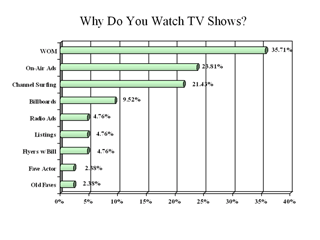media
Skip to
- The Storm's Coming for Cable Operators
- When it Comes to Retention, Content Remains King
- How do Cable Networks Retain Customers?
Nothing could be more frustrating today than not owning the relationship with
your customer. Not knowing why they spend on you or when they'll stop. Never
really being able to cater to them and yet always trying to understand what
they want. This is the world cable networks inhabit. The relationship with their
customer is actually owned by the cable operators - the Time
Warner Cables, Comcasts, Charters,
Adelphias - who send installers, repairmen,
and the bill. And these operators are so secretive with the details of their
subscriber base, including how they count them, that after nearly 25 years,
cable networks are still largely unfamiliar with the people who pay to subscribe
to their programming. So, given that retention and loyalty development is based
on knowing your customer and at the minimum, some sort of customer contact,
how on earth can a cable network justify investing in retention strategies?
 |
The
Storm's Coming for Cable Operators
And here's where things
will finally get interesting. The FCC has recently
issued requests to all the major operators for details on how they count their
subscribers, due to suspicions of over-counting. It started with telecom and
has now spread to cable and internet service providers. (Publishers have been
having their own bouts with how they count as well: "Measuring
Media Investments Without Measuring Reach")
Besides being used to determine the health of the company, subscriber bases are also used to determine fees cable operators pay for cable network programming (or in some cases, vice versa), and both parties use these figures to set rates for advertising. (Although, despite these challenges, advertisers are very comfortable with the relatively low rates charged by cable companies compared to network television rates. In fact, at this years upfront advertising market - that oft-berated, but heavily attended, annual ritual between advertisers and television broadcasters during which up to 70 to 80% of air time is promised, but not paid for, at discounted rates - cable did far better than network television, with a higher share of prime-time audiences.)
In no other industry do the producer and distributor have a more difficult symbiotic relationship. But consider that most cable operators are family or entrepreneur-owned, and culturally distance themselves from the sort of transparent relationships craved by corporate cable networks (- easily perceivable as greedy vendors by entrepreneurial founders.) Further, cable operators are largely unsophisticated when it comes to customer management due to their regional monopolies. (Their business models have always been based on granting access, not delivering content.) Although they do engage in acquisition and retention programs more actively than cable networks, even the threat of nation-wide digital satellite service hasn't yet caused enough of a fire under the seats of operators for them to change their practices.
And in this context, why should a cable network invest their money to keep subscribers happily paying an uncooperative cable operator who features competitors without preference? Especially since cable operators don't have any incentive to offer networks "a la carte", (per other FCC rumblings), preferring packaged cable that spread costs and guarantee fat margins for themselves? Cable networks can rightly perceive it to be in their best interests to focus the majority of their investments on "affiliate relationships" instead of consumer marketing, since consumers still can't request specific channels and cable operators have a cornucopia of revenue generating strategic alternatives (all of them seismic in their ability to change the cable network business) at their fingertips, including:
1) going digital;
2) launching their own competing cable networks;
3) accommodating dozens of new networks annually, including more profitable
pay-per-view/on-demand choices;
4) offering internet broadband services via their pipes;
5) giving away PVR (ad-skipping) boxes;
6) packaging phone call capabilities via voice-over internet protocol technology;
7) reselling wireless service branded with their names (1);
8) approaching advertisers directly with their ability to target audiences much
more precisely and just as broadly (thanks to their interconnects) across any
combination of networks playing on their system than any single network can.
 |
All ultimately diminish cable networks' negotiating power with cable operators.
When it Comes to Retention, Content Remains King
Despite all these tremendous obstacles, cable networks have an advantage over broadcast television - their ability to cater to anyone they want. Unlike the broadcast networks, faced with anti-competitive government limitations on their ability to expand their reach, regulations ferociously governing the level of indecency they broadcast over public airwaves, and dwindling audiences and advertisers (there's just less quality content, mostly due to skyrocketing production costs; and simultaneously, the cost of reaching 1000 people on network air has inflated faster than the national GDP, making it too expensive for reasonable media buyers), cable networks can and should invest increasingly into quality content for the fragmented masses.
In other words, marketing may acquire new viewers (at increasingly higher costs), but it cannot (cheaply) retain them if the content is irrelevant and unappealing. You may offer every bribe in the book, but if the writing, acting, or subject matter suck, you've wasted your money.
Most articles disseminated from the loyalty/retention industry overlook this fact, and as a result, readers are left believing that retention strategies can double as acquisition strategies (2). Give consumers the right prize, and they'll come running. Regrettably, consumers, fragmented as they are, no longer deem any prize worth the effort of continuing their use of your product. They need tailored prizes and constant back-and-forth dialogue, not to mention a really good product.
In the cable industry, acquisition must be something the networks work cooperatively with the operators on, primarily because the product networks offer is subjective and ultimately varies in value from consumer to consumer, while the product operators offer has not improved enough to justify the increased rates industry-wide. In fact, a May 2002 study from Accenture noted how consumers switched back to analog from digital faster than anticipated.
How do Cable Networks Retain Customers?
So what does a potential retention strategy look like for cable networks? Based on recommendations suggested in an al berrios & co. September 2003 study on premium cable (3), it includes:
- more research into all cable subscribers, not just your own, and information sharing between networks and operators, with "clean teams" facilitating to appease privacy and corporate-espionage hawks. This will drive sorely needed innovation into retention strategies, but most importantly, assist in negotiating fees with operators, as well as potentially the size of the bill sent to subscribers' homes, which is always a value-perception challenge;
 |
- less "shot-gun" marketing and more tailored, clearly differentiating dialogue with identified subscriber segments. A December 2003 microstudy by al berrios & co. (4) identified word of mouth, on-air promos, and channel surfing to be the dominant ways consumers discover new programming. In preceding media consumption studies by our firm during the year, the same programs were consistently ranked as favorites (i.e. The Simpsons), but often, consumers were clueless as to what networks aired their favorite programs. These findings all illustrate a huge gap in networks' marketing effectiveness and actual consumer involvement with network brands;
- working with the right incentive partners and alternative media to increase awareness, interest, and distribution of programming. Picking up from our last recommendation, the more strategically your programming is distributed (i.e. hotels, airports), the more relevant and precise your reach and the easier it will be to catch them while they surf, increasing the likelihood of retention.
Besides prominent examples like Disney, Nickelodeon, and the Discovery Channel (5), few networks actively engage and nurture retention or loyalty programs. Mainly, it's because they don't own the relationship, but it also has to do with the lack of innovation in cable retention strategies; among available concepts, there are fixtures like payment and credit cards and points for free trinkets, trial offer periods, and airline miles. Both Disney and Discovery have leveraged their retail presences in their programs, but no other cable networks can boast similar assets consumers may find relevant and worthwhile hooks for their loyalty (6). To complicate matters, the things that motivate consumers change faster than a retention program's ability to keep up. In other words, established retention programs simply can't do enough for cable because they are patterned after older, oft-copied programs that used to last indefinitely, are coolly received by bored customers, and deliver predictably low return on investment.
This is hardly a reason
for cable networks to desist from or discontinue their retention programs. But
it should serve as a red flag to engage in more research that profiles sub-segments
of their viewers by programming type and media preferences, spending patterns,
and competition for their entertainment dollar, to more effectively offer innovative
rewards that remind them you're appreciative of their decision to use your only
product - programming.
Write to Al Berrios at editor@alberrios.com
Top
Footnotes
(1) "Cable
Operators Eye Cellular Link"
(2) Incentive
Magazine archives
(3) "Comparing
the HBO and Showtime Consumers Using the al berrios & co. Research Approach"
(4) "Thirty-Five Percent of General U.S. T.V.
Viewing Population Is Prompted to Watch By Word of Mouth; 23.81% From On-Air
Ads; 9.52% From Billboards"
(5) "3-year-old
Loyalty Program Invites Cox into the Show"
(6) "Loyalty
programs seem to be all over the place now, so consumers have the possibility
of suffering from loyalty fatigue"
Top
Related alberrios.com Sections
> Our latest thinking on the media industry
> Our coverage of broadcasting, publishing,
entertainment, new
media, and wireless/telecom businesses
> Our research on
the media industry
> Our
latest thinking on consumer media habits
>
Read about our media industry-related events
> Our
analyses of the latest thinking in the media industry
> Learn
more about the media industry
> Academic
research on media
> News
about the media industry
Top
Disclaimer:
The recommendations, commentary and opinions published herein are based on
public information sometimes referenced via hyperlinks. Any similarities or
likeness to any ideas or commentary from any other sources not referenced
is purely coincidental. al berrios & co. cannot control any results occurring
from advice obtained from this publication nor any opinion(s) conveyed by
any reader of this publication.
(c) 2001-2005. All Rights Reserved. al berrios & company, inc. Published
by al berrios & co. This Report may not be reproduced or redistributed
in any form without written permission from al berrios & co., subject
to penalty.